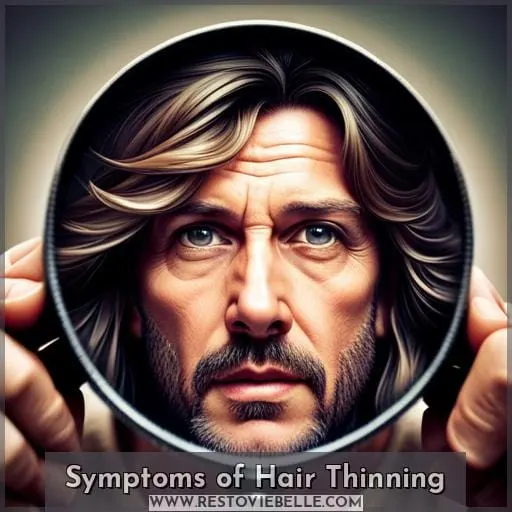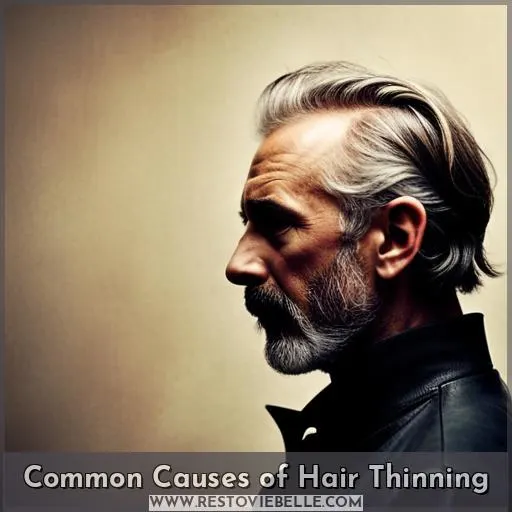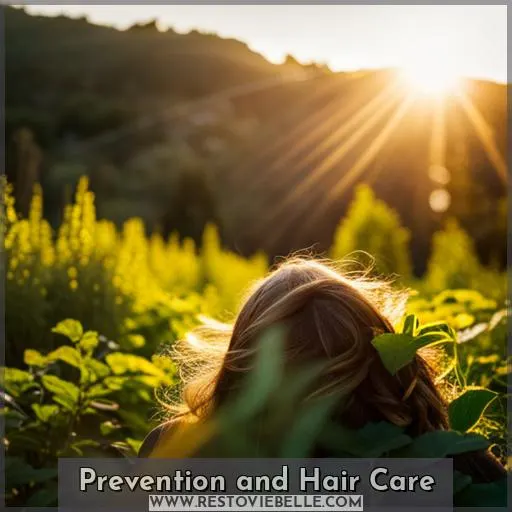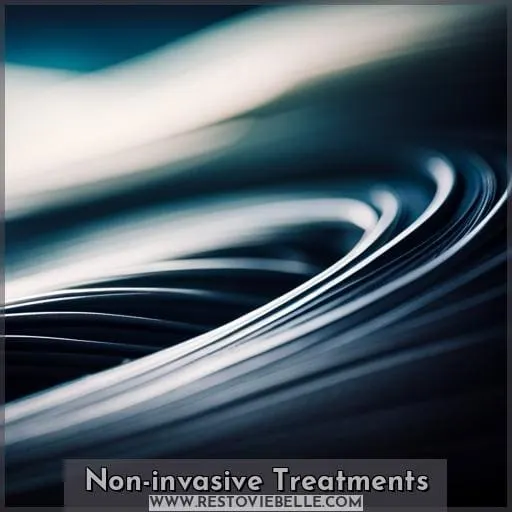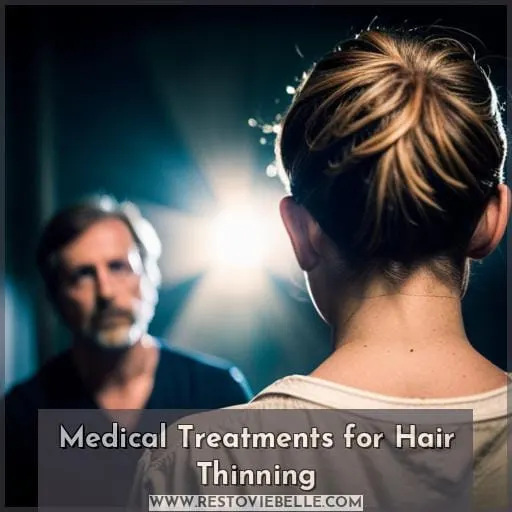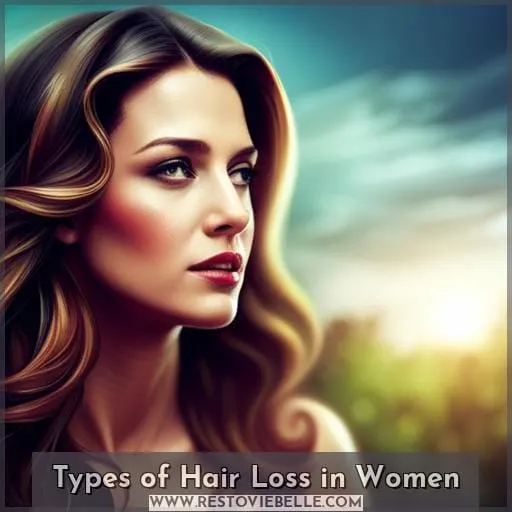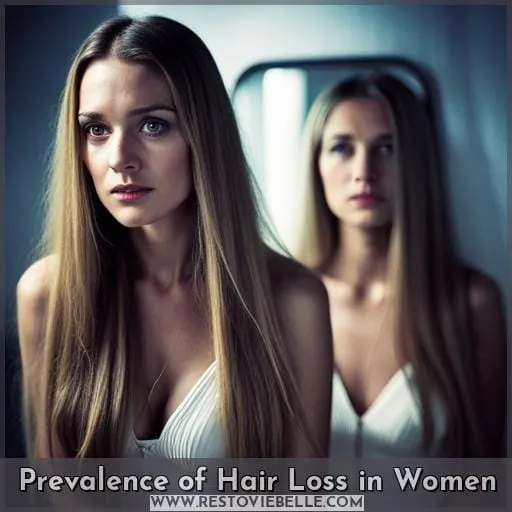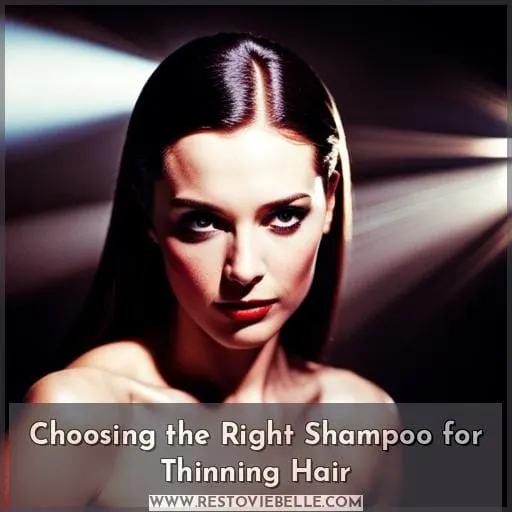This site is supported by our readers. We may earn a commission, at no cost to you, if you purchase through links.
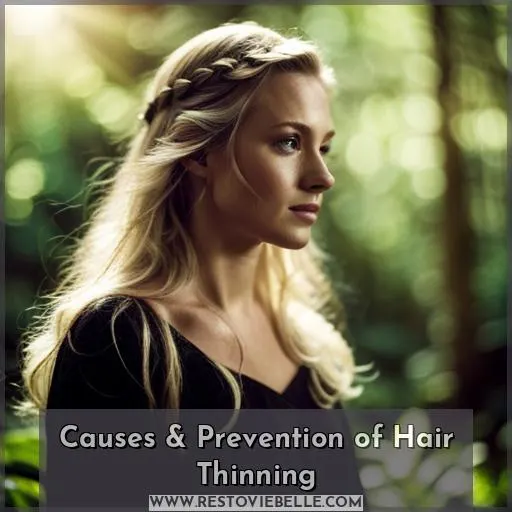 Unlock the secrets to reclaiming the power of your hair.
Unlock the secrets to reclaiming the power of your hair.
We all know that feeling when you look in the mirror and see your once-lush locks starting to thin.
The causes of hair thinning can be as diverse as the individuals who experience it, and understanding what’s behind it is the first step toward mastering this challenge.
Whether you’re a man or a woman, genetic factors, hormonal shifts, and lifestyle choices can all play a role in the thinning of your hair.
In this comprehensive guide, you’ll dive deep into the world of hair health. You’ll explore the symptoms, the root causes, and the risk factors that make your hair thin.
But we won’t stop there. You’ll also discover the keys to prevention and care, both non-invasive treatments and medical options to revive your crowning glory.
From the importance of a balanced diet to choosing the right products, we’ll empower you with the knowledge to take charge of your hair and make thinning a thing of the past.
Let’s unlock the secrets together and set you on the path to thicker, healthier hair.
Table Of Contents
- Key Takeaways
- Symptoms of Hair Thinning
- Common Causes of Hair Thinning
- Risk Factors for Hair Thinning
- Prevention and Hair Care
- Non-invasive Treatments
- Medical Treatments for Hair Thinning
- Lifestyle and Dietary Factors
- Understanding Hair Growth Cycles
- Types of Hair Loss in Women
- Prevalence of Hair Loss in Women
- Who is at Risk for Hair Thinning?
- Debunking Hair Loss Myths
- Choosing the Right Shampoo for Thinning Hair
- Conclusion
Key Takeaways
- Hair thinning can affect both men and women and is commonly characterized by widening part lines, scalp visibility, and reduced volume.
- Genetic factors, hormonal changes, and medical conditions can contribute to hair thinning, but lifestyle habits such as harsh styling and a poor diet can also play a role.
- Prevention strategies for hair thinning include scalp massage, using essential oils and anti-thinning shampoo, and maintaining a balanced diet with necessary vitamins and supplements.
- In severe cases, medical treatments like Minoxidil, Finasteride, and corticosteroids may be necessary, while non-invasive options like laser therapy can also help with hair regrowth.
Symptoms of Hair Thinning
When your once-lush mane starts to resemble a sparse forest, you might notice signs such as widening part lines, a gradual increase in the visibility of your scalp, and even a less voluminous appearance in your ponytail.
These are some common symptoms of thinning hair that require attention and understanding.
It is important to be aware of early signs so you can quickly identify underlying causes and take steps towards treatment or prevention. Thinning hair may have many potential causes ranging from heredity to hormonal changes or medical conditions like alopecia areata or trichotillomania (hair-pulling disorder).
Additionally, lifestyle factors such as overusing harsh styling treatments, tight hairstyles like cornrows, nutrient deficiencies due to poor dieting habits can also cause thinning hair problems. Understanding patterns associated with different types of baldness is essential when it comes to diagnosing what makes your hair thin accurately for proper remedies tailored specifically for each individual’s needs.
Thankfully, there are several methods available today which include scalp massage therapy using essential oils combined with multivitamin supplementations designed especially for those suffering from nutritional deficiencies caused by poor dietary practices.
Along with FDA-approved medications like Minoxidil proven effective against male pattern baldness, lifestyle modifications play an integral role too – quitting smoking, managing stress levels through relaxation techniques, etc.
All these measures should be taken into consideration when dealing effectively with the issue at hand if one wants long-lasting results without any further damage being done to their already weakened follicles.
Common Causes of Hair Thinning
You may notice your hair thinning due to heredity, hormonal changes, medical conditions, aging scalp infections, or medications. Hair loss can be caused by a number of factors, such as improper hair care habits and hormone imbalances.
Stress also has an effect on the health of your hair, with extreme emotional stress leading to increased levels of cortisol. This, in turn, causes changes in hormone production that result in excessive shedding and thinning of the hairs.
Dietary impact is another common factor for thinning hair. A lack of essential vitamins and minerals can lead to reduced thickness over time. Genetic factors are unavoidable if you have inherited genes from one or both parents that predispose you towards baldness or patchy alopecia.
In addition, lifestyle factors like smoking cigarettes are known contributors towards male pattern baldness. Unfortunately, this cannot be reversed once it sets in. However, other treatments exist such as medical interventions like drugs containing finasteride (propecia), which block DHT production.
This helps halt further damage while promoting regrowth when combined with topical minoxidil solutions specifically designed for treating female pattern baldness related issues caused by genetics/hormonal imbalances amongst others.
Some treatments for thinning hair include:
- Scalp massage
- Essential oils (use with caution)
- Anti-thinning shampoo
- Multivitamins (address nutritional deficiencies)
- Folic acid supplements (may treat folate deficiency)
Hair care should not be overlooked either. Being gentle with your locks and avoiding harsh treatments will help maintain healthy follicles. Protecting them from UV light exposure is key too! Taking steps now rather than waiting until more extensive damage occurs could limit any effects felt long term.
Risk Factors for Hair Thinning
Are you noticing your hair thinning? Genetics, hormonal changes, and lifestyle decisions can all play a role in the health of your hair. Genetic factors such as heredity or age may lead to thinning, while hormonal changes due to pregnancy or menopause can trigger it too.
Maintaining a healthy lifestyle through diet and exercise is important for strong locks as well.
Genetic Factors in Thinning
Genetically, you may be predisposed to thinning hair due to heredity or hormonal changes. Female-pattern hair loss is the most common type and is related to genetic influences passed down through family history.
It typically presents in a diffuse pattern with overall thinning rather than distinct bald patches.
Inherited traits from either parent can influence your risk of developing this condition as well as its severity, and certain hormones can also play a role in determining how much damage it does over time.
Family members may have similar thinning patterns that are often caused by the same underlying factors such as genetics or environmental triggers like stress levels or diet choices.
Knowing your family’s history of female-pattern hair loss can help you understand what might cause yours and take preventive measures if necessary so that it doesn’t become worse over time.
Impact of Hormonal Changes
Hormonal shifts can sometimes throw your hair for a loop, causing it to shed and become sparse. From menopause’s influence on thinning hairline to pregnancy-related shedding, hormones play an important role in our locks.
- Menopause causes fluctuating hormone levels, which can lead to increased shedding and thinning of the strands.
- Pregnancy brings about high estrogen levels that cause thicker tresses, as well as postpartum hormonal changes that may contribute to temporary balding or thinning of the mane after delivery.
- Thyroid hormones control metabolism, which affects not only weight but also impacts how much oil is produced by scalp glands. An imbalance leads to dryness and breakage, resulting in thinner-looking locks over time.
- Aging itself creates a decrease in the production of female sex hormones, leading weakened strands prone towards damage from heat styling or chemical treatments.
And don’t forget lifestyle factors like stress, smoking, poor nutrition – all impacting our precious manes! Knowing these risks helps us protect against further loss while keeping them healthy & strong!
Lifestyle and Hair Health
Your lifestyle habits can significantly impact the health of your hair, particularly in regards to thinning. Poor dietary choices, smoking, and stress have all been linked to sudden hair thinning or shedding in women.
To ensure healthy locks, it’s important to make healthier lifestyle choices such as eating a nutrient-rich diet and managing stress levels through relaxation techniques like yoga or meditation.
In addition, gentle handling of your tresses, including avoiding tight hairstyles, is recommended for preventing breakage, which can lead to anagen effluvium (involuntary loss of hairs).
Lastly, telogen effluvium caused by underlying medical conditions may also cause temporary hair loss that requires treatment from a healthcare professional.
Prevention and Hair Care
You don’t have to stand by helplessly as your hair thins. Simple changes to your hair care and lifestyle can prevent further thinning and even help regrow hair.
Start using a gentle, volumizing shampoo and conditioner. Massage your scalp thoroughly when shampooing to increase blood circulation. After washing, avoid rubbing your hair with a towel – gently squeeze out excess moisture instead.
Let your hair air dry to avoid damage from heat styling. If you must use hot tools, apply a heat protectant first.
Your diet affects your hair too. Make sure you’re getting enough protein, iron, zinc, vitamin C and vitamin D. Consider taking supplements if needed. Manage stress through yoga, meditation or therapy.
Finally, some essential oils may stimulate hair follicles when massaged into the scalp – try rosemary, peppermint or lavender oils. With good hair care habits and a healthy lifestyle, you can take control over your hair thinning.
Non-invasive Treatments
Losing your hair can be distressing, but there are some simple things you can try before resorting to more invasive treatments. To start, try a soothing scalp massage using essential oils like rosemary and peppermint.
Switching to an anti-thinning shampoo designed to thicken strands can also help. Taking a daily multivitamin ensures you get enough nutrients for healthy hair growth.
Scalp Massage
Get relief fast with a soothing scalp massage. The gentle kneading action increases blood flow to nourish hair follicles while tender touches release tension for healthier, fuller locks. A scalp massage can quickly ease tension. Slow circular motions with your fingertips boost circulation to hair follicles, nourishing roots.
Light touches relax muscles, unwinding stress for the health of your hair. Knead gently across the scalp to boost shine and volume.
Essential Oils
While applying essential oils to the scalp may seem beneficial, use them with caution as they can potentially irritate sensitive skin. It’s best to dilute essential oils with carrier oils and do a skin test first. Seek guidance on safe usage before applying them.
Some oils may stimulate follicles when gently massaged into the scalp, but it’s better to approach essential oils as a complementary treatment rather than a primary one for hair growth.
Anti-thinning Shampoo
Try an anti-thinning shampoo for fuller-looking hair. Assess the ingredients for proven effectiveness. Nourish strands, energize follicles, and revitalize volume with the right formula.
Multivitamins
Turn to multivitamins for a supplement that ironically thickens your mane!
- Ensure you’re getting enough vitamins and minerals.
- Look for B vitamins, zinc, and iron.
- Research brands for quality and effectiveness.
- Consult your doctor before beginning supplements.
Targeting nutritional deficiencies fortifies follicles.
Folic Acid Supplements
Your hair will thank you if you start taking folic acid supplements. Benefits include addressing deficiency, promoting growth and thickness, and restoring natural color and shine. Evaluate dosage needs based on sources like leafy greens or fortified foods. Folic acid for hair can reduce thinning caused by nutrient deficit.
Biotin
Biotin may be worth considering as a potential solution for hair thinning. While more research is still needed, biotin shows promise in supporting hair health. Good sources of biotin include supplements, liver, fish, meat, eggs, nuts and seeds.
The recommended daily dosage is 30 mcg. It’s advisable to consult your doctor before starting any new supplements.
Omega-3 and Omega-6 Fatty Acids
Try taking omega-3 and omega-6 fatty acid supplements, as they are thought to help strengthen your hair. Getting enough of these healthy fats from food or supplements may give your locks a boost. Focus on omega-3s from fish, nuts, seeds; and omega-6s from plant oils. Balance is key for hydrated, shiny strands.
Medical Treatments for Hair Thinning
Hair thinning and loss can significantly impact your self-image and confidence. Medical treatments like minoxidil, finasteride, and corticosteroids require prescriptions but can help regrow hair when lifestyle changes alone aren’t enough.
Minoxidil
A dab of Minoxidil foams your thinning mane like sea foam on ocean waves, stimulating follicles and sprouting new growth. Despite initially shedding hairs, consistent use restores volume and density. However, it is ineffective for receding hairlines or complete baldness.
Without continued application, the effects reverse. Though safe, potential side effects include unwanted facial or body hair and scalp irritation.
Spironolactone
You’ll want to ask your doctor about spironolactone, an oral medication that can help with thinning hair in some women. It works by regulating hormones associated with hair loss and is often effective for treating female pattern baldness.
Side effects may include breast tenderness or irregular menstrual cycles, so it’s important to discuss dosage guidance and user experiences when considering this option. Spironolactone has been shown to be quite effective at reversing the signs of hair thinning; however, there are still many unknowns about its use in this regard so make sure you talk through all the possible risks before beginning a course of treatment.
Finasteride
Take finasteride, an FDA-approved oral medication for male hair loss, to help thicken your locks with a renewed vibrancy. This potent drug blocks hormones that shrink hair follicles. But realize there can be side effects and alternatives.
Carefully follow dosage guidelines, discuss long-term use with your doctor, and weigh potential benefits against risks.
Corticosteroids
Corticosteroids may be prescribed to help you manage hair thinning, so talk with your healthcare provider about this option. These treatments can help reduce inflammation and suppress the immune system for those dealing with certain medical conditions.
However, side effects like headaches and nausea should also be considered before beginning a course of treatment. Hair regrowth is possible following corticosteroid use but will depend on individual dosage recommendations from your doctor or specialist.
At-home Laser Therapy
Place lasers near the scalp: beams guide more hair, claiming roots. Laser therapy benefits include safety concerns and efficacy studies; home devices and user experiences. Hair thinning no longer means total baldness—lasers provide a safe option with proven effects to boost and thicken existing follicles.
Lifestyle and Dietary Factors
Hair loss in women can be distressing, but there are lifestyle changes you can make to help prevent and treat thinning hair. Maintaining a balanced diet rich in nutrients, quitting smoking, managing stress through relaxation techniques or therapy, and adopting gentle hair care practices to minimize damage are all effective ways you can support healthy hair growth and minimize thinning.
To prevent hair loss, focus on getting enough protein, iron, zinc, and vitamin D. Massage your scalp regularly to increase blood flow. Try yoga, meditation, or counseling to reduce stress. Use wide-toothed combs and avoid excessive heat styling. With patience and care, you can keep your hair looking thick and healthy.
Balanced Diet
Keep healthy proteins like fish and iron sources like beans in your meal planning to support your hair. Fill your plate with nutrient-rich foods like avocado, nuts, and green leafy vegetables to nourish your hair from within.
Assess if poor eating habits or an imbalanced diet may contribute, and take charge by choosing a nutritional balance of vitamins, minerals, protein, and healthy fats. Hair health starts from the inside; empower yourself with the knowledge that lifestyle and dietary factors matter.
Quitting Smoking
Quitting smoking can help reduce hair loss, so make the commitment to break this habit for your health and beauty. Smoking has a huge impact on skin and hair. Nicotine withdrawal leads to improved circulation in the scalp, allowing for more nutrients that promote regrowth.
Taking advantage of smoking cessation programs will not only improve overall health but also restore the natural luster and shine of locks! With dedication, you’ll soon be seeing fuller strands with increased elasticity due to the restored balance of oil production.
Quitting smoking further enhances hair health as it reduces inflammation caused by smoke exposure from cigarettes or cigars.
Stress Management
Practice relaxation techniques to manage stress, as chronic stress contributes to thinning hair.
- Yoga
- Meditation
- Guided imagery
Managing stress through relaxation techniques or therapy supports emotional wellness and may reduce stress-related hair loss.
Hair Care Practices
| Dos | Don’ts |
|---|---|
| Use a wide-tooth comb | Brush hair when wet |
| Let hair air dry | Pull tightly when styling |
| Trim split ends regularly | Use hot tools daily |
| Deep condition weekly | Skip the conditioner |
| Protect hair from sun | Rub hair with towel |
Following these simple hair care practices can help prevent thinning and keep your hair looking naturally beautiful.
Understanding Hair Growth Cycles
Your hair naturally grows in cycles of growth, rest, and shedding. Understanding the complex hair growth cycles helps discern the causes of thinning hair.
The anagen phase is active hair growth, which lasts 2-7 years.
Catagen is a brief transition period.
Telogen is the resting phase when hair detaches and sheds, typically lasting 2-3 months before restarting the cycle.
Factors like hormones, genetics, age, and health influence hair growth. For example, postpartum hormone changes often cause excess shedding.
Myths persist about practices to encourage hair growth, but most lack scientific support.
While hair growth patterns differ among individuals, optimal self-care supports healthy hair cycles. Be gentle, use quality hair products, eat nutritiously, reduce stress, and consult a specialist for stubborn thinning issues.
With insightful self-awareness and proactive care, you can gain greater mastery over your hair’s natural rhythms.
Types of Hair Loss in Women
Recognizing the different types of hair loss in women can help you develop an effective treatment plan. Frontal fibrosing alopecia causes recession of the hairline. Alopecia areata results in patchy bald spots.
Trichotillomania is a disorder involving the urge to pull out your own hair. Take note of the patterns and location of thinning to identify possible causes.
Gradual thinning of hair across the top of your scalp may indicate female pattern baldness. Sudden, patchy loss could point to an autoimmune disorder like alopecia areata. Rapid shedding of hair all over your head may be telogen effluvium.
Don’t assume genetics are the only cause – get checked out for thyroid disorders, nutrient deficiencies, medications, or high stress levels too.
Knowing the type and pattern of your hair loss empowers you to address the root causes through lifestyle changes, medical treatment if needed, and targeted hair loss products. With the right insights and care, you can take control and restore your hair’s thickness.
Prevalence of Hair Loss in Women
Hair loss in women is a common issue, and the statistics are often surprising. An estimated 30 million women suffer from female pattern baldness, while another 40 percent of women will experience some type of hair thinning by age 50.
It’s important to understand that not all hair loss is permanent; many factors can lead to temporary or chronic shedding, including genetics and lifestyle choices like smoking or poor dieting habits. However, understanding these trends can help you determine if your own thinning hair may be caused by something more serious than just stress or normal aging processes.
Here are five facts about female baldness that everyone should know:
- Hair Loss Statistics: Women make up approximately 40% of those affected with alopecia worldwide. Moreover, it’s estimated that 30 million American women have hereditary forms of hair loss, as well as 10-15% experiencing other types such as traction alopecia due to tight hairstyles over time.
- Female Baldness Trends: Despite popular belief, men aren’t the only ones dealing with balding issues – roughly 35% of postmenopausal women report noticeable hair loss according to one study published in 2013.
- Hair Thinning Causes & Treatments: While there is no one size fits all cure for hair loss, in some cases, medical treatments like finasteride, minoxidil, corticosteroid injections, or laser therapy might help restore lost follicles over time.
- Women’s Hair Health Factors: Eating a balanced diet low in fats, rich in proteins, iron, zinc, vitamins A, C, D, E, B6, B12, and biotin, plus getting adequate sleep and exercise each day may also contribute to regular scalp health.
Who is at Risk for Hair Thinning?
Certain factors, like heredity, hormonal changes, and medical conditions can put you at risk for hair thinning. Genetic predisposition plays a significant role in the amount of hair you have; some people are just predisposed to having less, while others will have tons.
Hormonal influences are also important when considering your chances of developing thinning hair since hormones play an integral part in how our bodies function and grow.
Environmental factors, such as exposure to pollutants or UV light, can cause damage that leads to thinner locks over time too.
Nutritional aspects should not be ignored either, as it is possible for certain deficiencies from lack of vitamins or minerals to result in weaker strands overall.
Debunking Hair Loss Myths
Debunking the myths around hair loss is key to understanding and addressing thinning tresses. Many false beliefs about hair loss are still widely believed, such as wearing hats or wigs causing baldness in women or brushing one’s hair a hundred strokes per day making it healthier.
The truth is that there are many causes of thinning hair. These include heredity, hormonal changes, medical conditions like alopecia areata and trichotillomania (a pulling disorder), scalp infections due to harsh treatments or tight hairstyles like cornrows, aging, and nutritional deficiencies.
While lifestyle habits can have an effect on your locks – from using too many heat tools for styling purposes to having a poor diet – they don’t cause permanent damage unless left unchecked for extended periods of time.
Therefore, if you find yourself experiencing sudden shedding more than the usual amount during showering or brushing, talk with your doctor right away. Early diagnosis helps prevent further damage and bald patches from occurring in the future by identifying underlying causes accurately, so appropriate treatments may be recommended accordingly.
This could include prescription-only medication (like finasteride), over-the-counter topical solutions (like minoxidil), or laser therapy at home.
Additionally, taking care of basic health needs such as eating nutritious meals and regular exercise, along with reducing stress levels through relaxation techniques, would go a long way towards maintaining a healthy mane.
Choosing the Right Shampoo for Thinning Hair
Choosing the right shampoo is crucial for thinning hair. Look for gentle, volumizing formulas with key ingredients like biotin, keratin, ginseng, and saw palmetto that nourish strands, thicken hair diameter, and stimulate growth without weighing your locks down.
The correct shampoos will cleanse gently, add volume, and contain ingredients that provide hair health benefits. Focus on formulas with nourishing ingredients like biotin, keratin, ginseng, and saw palmetto to stimulate growth and thicken each strand without weighing hair down.
Volumizing shampoos with these ingredients will cleanse hair gently while stimulating growth and thickness.
Shampoo for Thinning Hair
You’ll want a shampoo containing ingredients that strengthen and thicken your hair strands without weighing them down. Look for natural oils like jojoba or argan that nourish follicles without leaving residue.
Tea tree oil also stimulates the scalp to produce healthier, thicker hair. And protein-rich ingredients like keratin reinforce strands. Brands like Nioxin and Viviscal make shampoos with these ingredients to combat thinning hair.
Remember, genetics and aging contribute most to hair loss in women – not hats or frequent brushing.
Choosing the Right Products
Finding the perfect shampoo for your thinning locks takes some trial and error, but don’t lose heart – there are options out there that’ll give those tresses a fighting chance.
Look for volumizing formulas.
Seek out ingredients like biotin and ginseng.
Ask your stylist for personalized recommendations.
Read reviews to gauge effectiveness.
Don’t be afraid to switch it up if something isn’t working.
When it comes to choosing products for thinning hair, persistence and patience are key. With the right shampoo, you can help strengthen your strands and reveal the fuller, thicker hair you know is in there.
Ingredients to Look For
When choosing the right shampoo for thinning hair, look for ingredients like minoxidil, spironolactone, and finasteride that can help restore your hair’s natural thickness. Natural remedies, such as dietary factors and nutrient supplements, are also important to consider when maintaining scalp health.
Hair care tips include being gentle with your locks and avoiding harsh treatments or tight hairstyles. Additionally, protect it from UV light by wearing hats or scarves in sunny weather while managing stress through relaxation techniques or therapy.
With all these considerations taken into account, you’ll be on track towards healthier tresses soon enough!
Conclusion
It’s a common misconception that thinning hair is something that affects only men, but the truth is that hair loss can happen to anyone regardless of gender or age. Thinning hair can be caused by a variety of factors, from genetic predisposition to lifestyle factors like smoking.
While some treatments and prevention methods are available, it’s important to understand the underlying causes of hair thinning in order to better manage it. Fortunately, with proper care, lifestyle changes, and the right products, it is possible to keep your hair looking and feeling its best.
So, if you’re noticing your hair thinning, don’t despair; you can still keep your hair looking beautiful and healthy.

